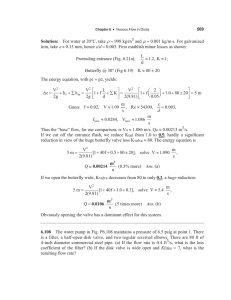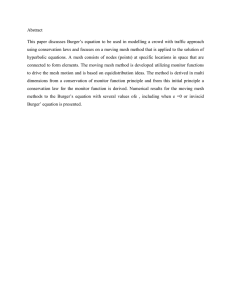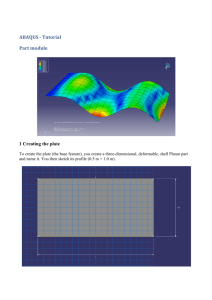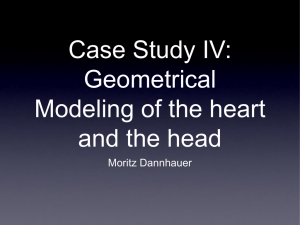Finite Element Meshing for Cardiac Analysis
advertisement
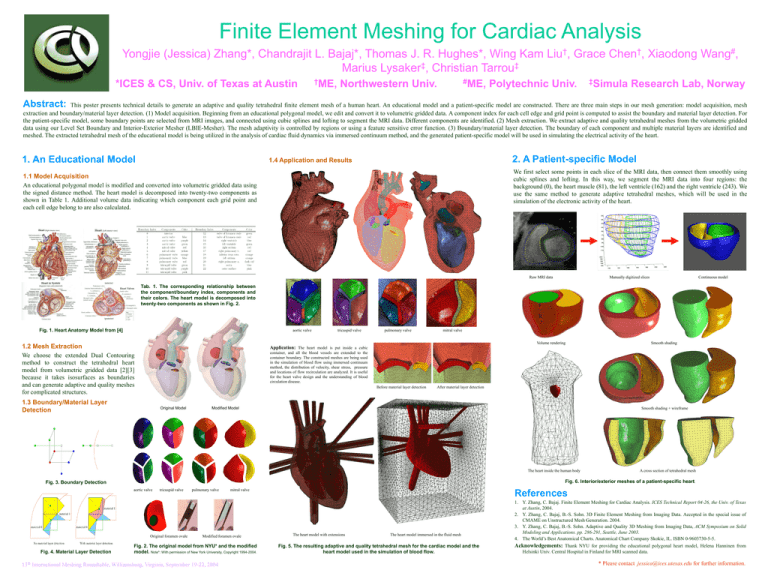
Finite Element Meshing for Cardiac Analysis Yongjie (Jessica) Zhang*, Chandrajit L. Bajaj*, Thomas J. R. Hughes*, Wing Kam ‡ ‡ Marius Lysaker , Christian Tarrou *ICES & CS, Univ. of Texas at Austin †ME, #ME, Northwestern Univ. † Liu , Grace Polytechnic Univ. † Chen , ‡Simula Xiaodong # Wang , Research Lab, Norway Abstract: This poster presents technical details to generate an adaptive and quality tetrahedral finite element mesh of a human heart. An educational model and a patient-specific model are constructed. There are three main steps in our mesh generation: model acquisition, mesh extraction and boundary/material layer detection. (1) Model acquisition. Beginning from an educational polygonal model, we edit and convert it to volumetric gridded data. A component index for each cell edge and grid point is computed to assist the boundary and material layer detection. For the patient-specific model, some boundary points are selected from MRI images, and connected using cubic splines and lofting to segment the MRI data. Different components are identified. (2) Mesh extraction. We extract adaptive and quality tetrahedral meshes from the volumetric gridded data using our Level Set Boundary and Interior-Exterior Mesher (LBIE-Mesher). The mesh adaptivity is controlled by regions or using a feature sensitive error function. (3) Boundary/material layer detection. The boundary of each component and multiple material layers are identified and meshed. The extracted tetrahedral mesh of the educational model is being utilized in the analysis of cardiac fluid dynamics via immersed continuum method, and the generated patient-specific model will be used in simulating the electrical activity of the heart. 1. An Educational Model 2. A Patient-specific Model 1.4 Application and Results We first select some points in each slice of the MRI data, then connect them smoothly using cubic splines and lofting. In this way, we segment the MRI data into four regions: the background (0), the heart muscle (81), the left ventricle (162) and the right ventricle (243). We use the same method to generate adaptive tetrahedral meshes, which will be used in the simulation of the electronic activity of the heart. 1.1 Model Acquisition An educational polygonal model is modified and converted into volumetric gridded data using the signed distance method. The heart model is decomposed into twenty-two components as shown in Table 1. Additional volume data indicating which component each grid point and each cell edge belong to are also calculated. Raw MRI data Manually digitized slices Continuous model Tab. 1. The corresponding relationship between the component/boundary index, components and their colors. The heart model is decomposed into twenty-two components as shown in Fig. 2. Fig. 1. Heart Anatomy Model from [4] aortic valve tricuspid valve pulmonary valve mitral valve Volume rendering 1.2 Mesh Extraction We choose the extended Dual Contouring method to construct the tetrahedral heart model from volumetric gridded data [2][3] because it takes isosurfaces as boundaries and can generate adaptive and quality meshes for complicated structures. Application: The heart model is put inside a cubic container, and all the blood vessels are extended to the container boundary. The constructed meshes are being used in the simulation of blood flow using immersed continuum method, the distribution of velocity, shear stress, pressure and locations of flow recirculation are analyzed. It is useful for the heart valve design and the understanding of blood circulation disease. Before material layer detection 1.3 Boundary/Material Layer Detection Original Model After material layer detection Modified Model Smooth shading + wireframe The heart inside the human body A cross section of tetrahedral mesh Fig. 6. Interior/exterior meshes of a patient-specific heart. Fig. 3. Boundary Detection aortic valve tricuspid valve Original foramen ovale Fig. 4. Material Layer Detection Smooth shading pulmonary valve mitral valve Modified foramen ovale Fig. 2. The original model from NYU* and the modified model. Note*: With permission of New York University, Copyright 1994-2004. 13th International Meshing Roundtable, Williamsburg, Virginia, September 19-22, 2004 References The heart model with extensions The heart model immersed in the fluid mesh Fig. 5. The resulting adaptive and quality tetrahedral mesh for the cardiac model and the heart model used in the simulation of blood flow. 1. Y. Zhang, C. Bajaj. Finite Element Meshing for Cardiac Analysis. ICES Technical Report 04-26, the Univ. of Texas at Austin, 2004. 2. Y. Zhang, C. Bajaj, B.-S. Sohn. 3D Finite Element Meshing from Imaging Data. Accepted in the special issue of CMAME on Unstructured Mesh Generation. 2004. 3. Y. Zhang, C. Bajaj, B.-S. Sohn. Adaptive and Quality 3D Meshing from Imaging Data, ACM Symposium on Solid Modeling and Applications. pp. 286-291, Seattle, June 2003. 4. The World’s Best Anatomical Charts. Anatomical Chart Company Skokie, IL. ISBN 0-9603730-5-5. Acknowledgements: Thank NYU for providing the educational polygonal heart model, Helena Hanninen from Helsinki Univ. Central Hospital in Finland for MRI scanned data. * Please contact jessica@ices.utexas.edu for further information.



